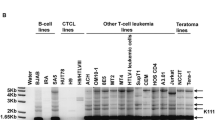Abstract
Previous studies from our laboratory have described two endogenous provirus-like sequences in a series of cosmids spanning theTL region of the major histocompatibility complex (MHC) of normal C57BL/10 mice. At least one of these viruses shares similarities withVL30 elements. To determine if additionalVL30-like retroviral elements are integrated in the MHC, we constructed a cosmid library using DNA from a radiation leukemia virus (RadLV)-transformed cell line derived from C57BL/6 mice. The library was first screened using theH-2III (5′) probe, which detects Class I genes of theH-2 complex. In the primary screening 163H-2III positives were isolated. TheH-2III-positive isolates were then hybridized with an AKR-derived virus probe,EcoB/S, which contains sequences from both thepol and theenv genes of the virus. Nine virus-positive isolates were detected. Localization of these cosmid isolates containing viral sequences within theH-2 complex was done utilizing low-copy probes and confirmed using previously mapped cosmid isolates from other laboratories. We report here the isolation and characterization ofVL30-like elements from theQa andD regions of theMHC of several inbred mouse strains.
Similar content being viewed by others
References
Adams, S. E., Rathjen, P. D., Stanway, C. A., Fulton, S. M., Milim, M. H., Wilson, W., Ogden, J., King, L., Kingsman, S. M., and Kingsman, A. J. (1988). Complete nucleotide sequence of VL30 retro-element.Mol. Cell. Biol. 82989.
Besmer, P., Olshevsky, U., Baltimore, D., Dolberg, D., and Fan, H. (1979). Virus-like 30S RNA in mouse cells.J. Virol. 291168.
Bluestone, J. A., Cron, R. Q., Crotterman, M., Houlden, B. A., and Matis, L. A. (1988). Structure and specificity of TCR γδ receptors on major histocompatibility complex antigen specific CD3+, CD4−, CD8−, T lymphocytes.J. Exp. Med. 1681899.
Brown, G. D., Choi, Y. C., Egan, G., and Meruelo, D. (1988a). Extension of the H-2 TLb molecular map.Immunogenetics 27239–251.
Brown, G. D., Choi, Y. C., Pampeno, C., and Meruelo, D. (1988b). Regulation of H-2 Class I gene expression in virally transformed and infected cells.CRC Crit. Rev. Immunol. 8175.
Brown, G. D., Egan, G., Choi, Y. C., and Meruelo, D. (1989). Comparative analysis of TLb and TLc gene organization. In Dupont, B. (ed.),Immunology of HLA, Vol. II Springer-Verlag, New York, p. 175.
Courtney, M. G., Elder, P. K., Steffen, D. L., and Getz, M. J. (1982). Evidence for an early evolutionary origin and locus polymorphism of mouse VL30 DNA sequences.J. Virol. 43511.
Elliot, E., Rathbun, D., Ramsingh, A., Garberi, J., and Flaherty, L. (1989). Genetics and expression of the Q6 and Q8 genes. An LTR-like sequence in the 3′ untranslated region.Immunogenetics 29371.
Foster, D. N., Schmidt, L. J., Hodgson, C. P., Moses, H. L., and Getz, M. J. (1982). Polyadenylated RNA complementary to a mouse retrovirus-like multigene family is rapidly and specifically induced by epidermal growth factor stimulation of quiscent cells.Proc. Natl. Acad. Sci. USA 797317.
Hodgson, C. P., Elder, P. K., Ono, T., Foster, D. N., and Getz, M. J. (1983). Structure and expression of mouse VL30 genes.Mol. Cell Biol. 32221.
Houlden, B. A., Matis, L. A., Cron, R. Q., Widacki, S. M., Brown, G. D., Pampeno, C., Meruelo, D., and Bluestone, J. A. (1989). A TCR gd cell recognizing a novel TL encoded gene product.Cold Spring Harbor Symp. Quant. Biol. LIV45.
Howk, R. S., Troxler, D. H., Lowy, D., Duesberg, P. H., and Sconlnick, E. M. (1978). Identification of a 30S RNA with properties of a defective type C virus in murine cells.J. Virol. 25115.
Maniatis, T., Fritsch, E. F., and Sambrook, J. (1982).Molecular Cloning. A Laboratory Manual Cold Spring Harbor Laboratory, Cold Spring Harbor, N.Y.
Meruelo, D., Rossamando, A., Offer, M., Baxbaum, J., and Pellicer, A. (1983). Association of endogenouses viral loci with genes encoding murine histocompatibility and lymphocyte differentiation antigens.Proc. Natl. Acad. Sci. USA 805032.
Meruelo, D., Kornreich, R., Rossomando, A., Pampeno, C., Mellor, A. L., Weiss, E. H., Flavell, R. A., and Pellicer, A. (1984). Murine leukemia virus sequences are encoded in the murine major histocompatibility complex.Proc. Natl. Acad. Sci. USA 811804.
Pampeno, C. L., and Meruelo, D. (1986). Isolation of a retrovirus-like sequence from the TL locus of the C57BL/10 murine major histocompatibility complex.J. Virol. 58296.
Pampeno, C., and Meruelo, D. (1988). Genomic orgnaization of the mouse Tla locus: Study of an endogenous retrovirus-like locus reveals polymorphisms related to different Tla haplotypes.Immunogenetics 28247.
Rossomando, A., and Meruelo, D. (1986). Viral sequences are associated with many histocompatibility genes.Immunogenetics 23233.
Sherwin, S. A., Rapp, U. R., Benveniste, R. E., Sen, A., and Todaro, G. J. (1978). Rescue of endogenous 30S retroviral sequences from mouse cells by baboon type C virus.J. Virol. 26257.
Steinmetz, M., Frelinger, J. B., Fisher, D., Hunkapiller, T., Pereira, D., Weissman, S. M., Uehara, H., Nathenson, S., and Hood, L. (1981). Three cDNA clones encoding mouse transplantation antigens: Homology to immunoglobulin genes.Cell 24125.
Steinmetz, M., Winoto, A., Minard, K., and Hood, L. (1982). Clusters of genes encoding mouse transplantation antigens.Cell 28489.
Struhl, K. (1985). A rapid method for creating recombinant DNA molecules.Biotechniques 3452.
Weiss, E. H., Golden, L., Fahrner, K., Mellor, A. L., Devlin, J. J., Bullman, H., Tiddens, H., Bud, H., and Flavell, R. A. (1984). Organization and evolution of the Class I gene family in the major histocompatibility complex of the C57BL/10 mouse.Nature 310650.
Author information
Authors and Affiliations
Rights and permissions
About this article
Cite this article
Choi, Y., Meruelo, D. Isolation of virus-like (VL30) elements from theQ10 andD regions of the major histocompatibility complex. Biochem Genet 29, 91–101 (1991). https://doi.org/10.1007/BF00578242
Received:
Revised:
Issue Date:
DOI: https://doi.org/10.1007/BF00578242




